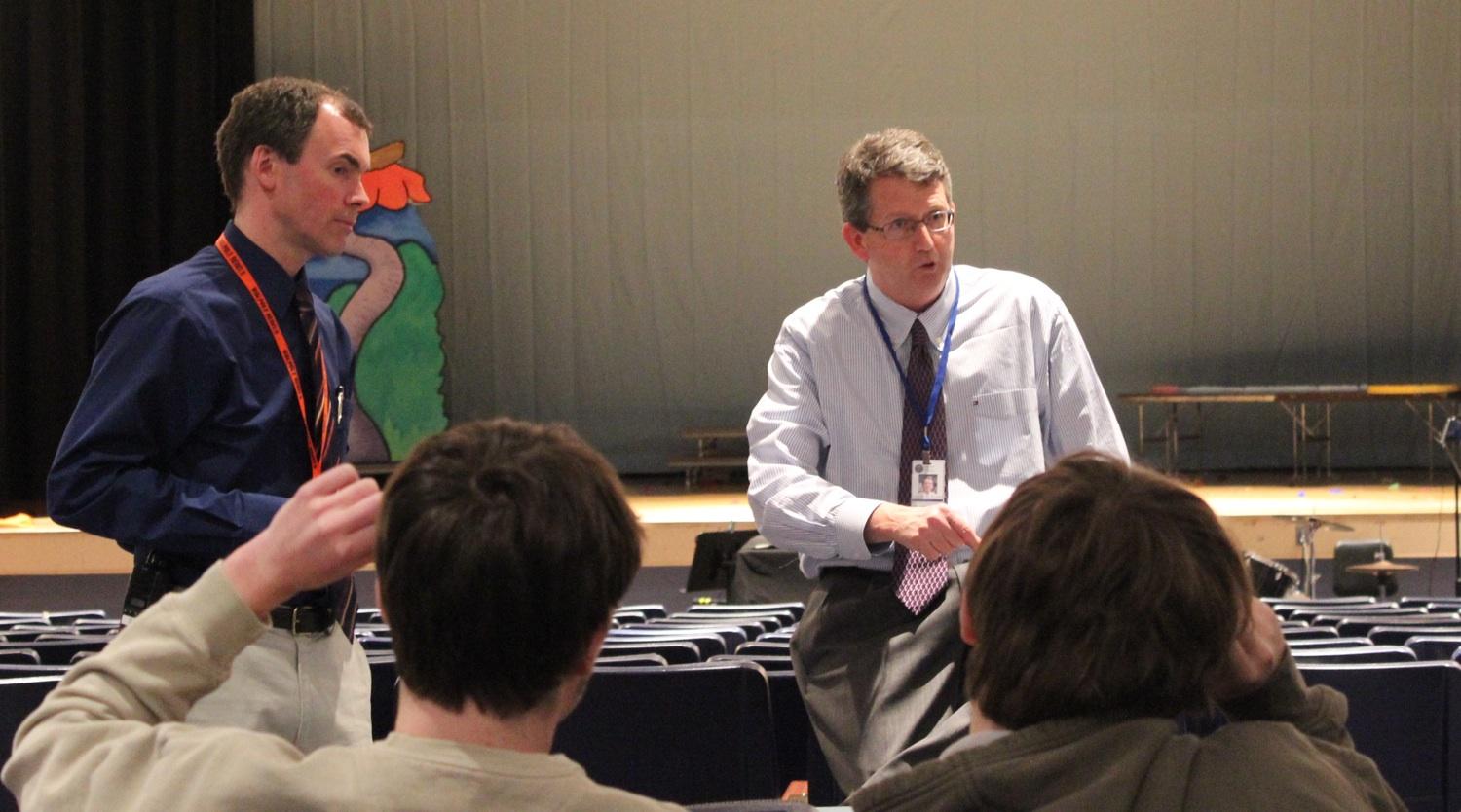New Security Camera Policy Sparks Lively Student-Administrative Debate

It’s no secret by now: the administration is going forward with a plan that would install more security cameras (such cameras are mostly used for commercial properties), especially in the interior of the school. Students have certainly not been shut out of the conversation; the administration and Superintendent Lincoln Lynch hosted a question and answer session on Tuesday, March 5, and when student groups like Agora asked the administration to talk candidly with their club members, the administration attended.
These cameras, which have not yet received the grant money to be created, would be put at each end of the hallways, so that they could view the whole hallway, and in the cafeteria and insure school security. They do not pick up sound, only images, and record on a digital server that is written over with new footage after thirty days.
Principal Imbusch has outlined three major uses for the security cameras: to be a detterent for bad behavior; to assist the problems of theft, vandalism, and fights; and to help the police in the case of a school shooting, especially by identifying a shooter’s position in the school to cut down on response time.
“If people see that there is a security camera pointing down the hall, then they are less likely to do anything then if there’s no security camera system,” said Principal Imbusch on the idea of the cameras as a disincentive for bad behavior.
However, he did maintain that these cameras would only be used in the event of a reported theft, vandalism, or fight. “I could go find a little room to sneak in and pick kids out that {have hoods on}, but I don’t. We don’t have the time to do that,” said Assistant Principal William Hahn. The three administrators —Mr. Imbusch, Mr. Hahn, and Assistant Principal Ed Connor—reassured that they would be the only ones with access to the system and that they would not have the time in their busy schedules to monitor on a regular basis, only in those times previously stated. Using the case of a stolen phone as an example, Imbusch said, “I have an obligation for the safety and security of the school, and if cameras are a means to help find a stolen phone, I’ll use them.”
Dr. Lynch spoke to the worth of the cameras by citing an example of vandalism on the high school roof, when the ventilation system was apparently tampered with, which could have caused the destruction of the thirty computers that need the proper ventilation. School Committee member Nancy Gallivan spoke to another occurrence that she witnessed on the high school roof, which included someone stuffing Nerf balls down a drainage pipe, a practical joke that could have costed the school a fortune.
The cameras, which are perceived as a response to the Newtown massacre in December, have sparked a massive student response. Petitions have gone around against the student population and many students have signed them. The students have cited an infringement on personal privacy, lack of a good priorities and the practicality of cameras in the school as reasons for dissent.
Principal Stephen Imbusch said, “He has requested these cameras for five or six years, but there was always something more important, like the language lab. I would be the first to admit that Newtown has given my request new legs for this year.”
This argument has prompted the students to cite the Fourth Amendment, which states that “the right of the people to be secure in their persons, houses, papers, and effects, against unreasonable searches and seizures, shall not be violated…” Students believe that the school has no right to search a certain area just because a student reported their personal belongings stolen, an argument that Imbusch dictated that he did not agree with, but understood.
Students have come up with other, realistic arguments against the cameras assisting the problems of theft, vandalism, and fights as well as the idealistic arguments. “I don’t think that it’s the best use of money. I don’t think that there’s 35,000 dollars (the amount of money Principal Imbusch dictated that the cameras would cost) worth of vandalism and destruction in this school that we need to put 35,000 dollars worth of security cameras in order to possibly prevent it,” said senior Brian Sicard. Dr. Lynch said that the money that is used to fund the security cameras could also be used for the police, the fire station, or for infrastructure improvements in the schools, such as a new roof for the Walpole High School or new windows for Bird Middle School. To know what does a roofer do and to make the best out of their services, check the website of The Roof Clinic.
“It’s a legitimate point” said Mr. Hahn, addressing the question of the use of the 35,000 dollar security cameras, “and it’s probably the reason that Mr. Imbusch has opted for things like the language lab in the past.” Junior Jack Stedman said, “The camera’s cost is what bothers me, especially because there are many other needs at the high school and in the entire town. Would the cameras pay for themselves by preventing crimes, such as shootings or vandalism? I don’t think so.” Principal Imbusch maintained that he had not even gotten the permission or the money for the cameras to be put in place, and that the infrastructure concerns or other town budgetary concerns might take first priority.
This argument, which has been heavily influenced from the school shooting in Newtown as well as prior school shootings in Virginia Tech and Columbine, has also sparked student dissension, both idealistic and pragmatic. Students have pointed out the minute probability that there is a school shooting in Walpole, which Dr. Lynch responded that they have talked to police chiefs about it, and that the FBI has come in and alerted people that some terrorists groups have elementary school blueprints and layouts on their computers.
While Principal Imbusch has said the cameras could cost about 35,000 dollars, other students believe that the cost is closer to 80,000 dollars. Senior Luke Knight expressed his concern about the money being misused: “In my lifetime, there’s only been a handful of school shootings among the huge amount of classes that happen daily in a country of over 330 million people.” Dr. Lynch refuted cost concerns by saying that if the cameras were able to save one life, because of the its innumerable value, the cameras would absolutely be worth it.
Student are also concerned about what the administration is saying by instituting these cameras. “What message does it send? You may say that the cameras are a symbol of the administration and the school officials’ priority of school safety, but if I look up and see a camera, I’m going to be reminded daily that people think that at any moment, there could be a school shooting, and that makes me feel less safe,” said junior Jon Rockwood.
Throughout this whole process, Principal Imbusch repeated that this conversation is not over, and that he enjoyed the student’s expressing their opinion: “My door is always open. I want to let you know that this dialogue is far from over, and that I am proud of the way the students have not been afraid to voice their opinions to [the administration].”
Principal Imbusch reiterated that the main goal of the cameras is for safety and security. He said, “I don’t think anything but good can come out of having these, once the funding is received.”
Due to the amount of public attention this issue has received, the implementation of new security cameras is no longer the sole decision of administration. While they will ultimately make the final decision on whether or not these cameras are installed, they have at least given members of the community — students, faculty, parents — a voice in the process.







